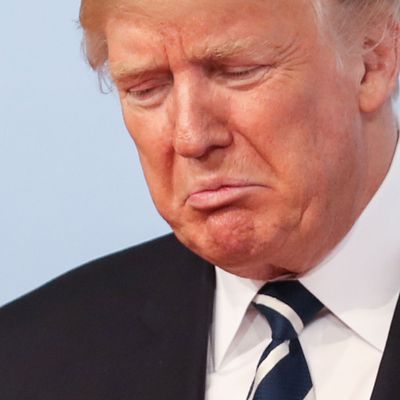
Since blocking key aspects of Donald Trump’s watered-down travel ban, U.S. district judge Derrick Watson has been through a lot. The president complained about his ruling. Jeff Sessions berated him and his state as some judge on an island in the Pacific. He’s gotten threats from Trump supporters. All for concluding that Trump’s executive order temporarily excluding travelers and refugees from six Muslim-majority nations is likely unconstitutional for targeting members of a particular faith.
Watson’s bold action in March, which prevented the Trump administration from enforcing one of its proudest policy initiatives, was followed by timidity late on Thursday, when he declined a request by the state of Hawaii to do what federal judges do all the time: interpret, implement, and apply guidance from a higher authority.
In this case, that higher power was the Supreme Court itself, which last week took the liberty of narrowing the scope of Watson’s original ruling against the ban — as well as a separate one from Maryland — which effectively barred the government from moving forward at all with its plans. The justices struck a compromise: Let’s keep the ban on the ban in place, but let’s allow Trump to enforce it against anyone from the affected Mideast countries who lacks a “bona fide relationship” to a person or entity in the United States. Justice Clarence Thomas, who would’ve put the entire ban back into effect, predicted that his colleagues’ middle-of-the-road approach would bring a flood of litigation and uncertainty.
Indeed, Hawaii was back in court that same week, complaining that the Trump administration adopted a tortuous reading of the Supreme Court’s orders — mainly by interpreting a “bona fide relationship” as excluding grandmothers, fiancées, aunts, and other family members of those already here. The same for refugees: Having an established relationship with a refugee resettlement agency in the U.S. doesn’t mean the relationship is bona fide, or in good faith. (Not even the administration was convinced it was making the right call, as it soon after changed course and agreed that brides- and grooms-to-be are covered by the justices’ language.)
So it fell to Watson to clarify what the Supreme Court meant. Judges do that all the time, right? Not this time. In a strange twist, he washed his hands of this controversy and all but said, That ain’t my job. That’s my bosses’ job. They own this. He wrote:
Upon careful consideration of the parties’ submissions, it is evident that the parties quarrel over the meaning and intent of words and phrases authored not by this Court, but by the Supreme Court in its June 26, 2017 per curiam decision. That is, the parties’ disagreements derive neither from this Court’s temporary restraining order, this Court’s preliminary injunction, nor this Court’s amended preliminary injunction, but from the modifications to this Court’s injunction ordered by the Supreme Court. Accordingly, the clarification to the modifications that the parties seek should be more appropriately sought in the Supreme Court.
What a punt. But there is some truth to what Watson is saying here: He never once used the “bona fide” standard that the Supreme Court came up with. That was the justices’ doing — a pragmatic result that, as University of Chicago law professor Daniel Hemel has pointed out, “prioritizes institutional legitimacy over doctrinal consistency.” They literally made it up just for the purposes of this case, which is now on their docket and they’ll consider more in depth when they reconvene in October at the start of the new term.
Until then, it is up to judges like Watson to figure out what the Supreme Court meant. It would be wrong for him to contradict the Supreme Court or go above and beyond its directives. But filling in the gaps in light of what’s already been laid down as the law of the land is what judges do all the time. Just not here, apparently.
So what’s behind all this coyness after his initial boldness? Could it be the pressure from Trump, his attorney general, and their backers is getting to him? Ilya Somin, a law professor who has been following closely the travel ban litigation, theorized that Watson “genuinely believes that only the Supreme Court itself can interpret its ruling on the injunction. But it’s a strange and dubious conclusion nonetheless.”
Hawaii wasted no time. Neal Katyal, the high-powered Supreme Court lawyer representing the Aloha State in this case, said he and his team were “up most of the night” getting ready to fight the Trump administration’s exclusion of grandmothers and others in a similar situation, which he said “inflicts great harm.” But rather than taking a page from Watson’s playbook, they won’t go to the Supreme Court right away. Instead, they’ll go to the Ninth Circuit, which hasn’t been shy at all about speaking its mind, twice already, on how the travel ban is against the law.
(Update: Later Friday, the Ninth Circuit punted in its own way. The appeals court suggested that Hawaii should’ve never asked for a clarification in the first place, but instead ask outright for an order seeking to enforce the Supreme Court’s guidance against the Trump administration. Hawaii did just that by going back to Watson early Saturday.)





























